Book contents
- Frontmatter
- Contents
- Acknowledgments
- 1 Introduction: Planning Agents in a Social World
- PART ONE ACCEPTANCE AND STABILITY
- 2 Practical Reasoning and Acceptance in a Context
- 3 Planning and Temptation
- 4 Toxin, Temptation, and the Stability of Intention
- PART TWO SHARED AGENCY
- PART THREE RESPONSIBILITY AND IDENTIFICATION
- PART FOUR CRITICAL STUDIES
- Index
2 - Practical Reasoning and Acceptance in a Context
Published online by Cambridge University Press: 18 December 2009
- Frontmatter
- Contents
- Acknowledgments
- 1 Introduction: Planning Agents in a Social World
- PART ONE ACCEPTANCE AND STABILITY
- 2 Practical Reasoning and Acceptance in a Context
- 3 Planning and Temptation
- 4 Toxin, Temptation, and the Stability of Intention
- PART TWO SHARED AGENCY
- PART THREE RESPONSIBILITY AND IDENTIFICATION
- PART FOUR CRITICAL STUDIES
- Index
Summary
In practical reasoning and action we seek to realize our intentions and satisfy our desires in the light of what we believe. Or so we are taught to say. In this essay I question the last clause and suggest that the cognitive attitudes guiding practical reasoning and action go beyond our beliefs. I begin by locating my problem within the planning conception of practical reasoning I have developed elsewhere (Bratman 1987).
PRIOR PLANS AND THE BACKGROUND OF DELIBERATION
As I see it, prior intentions and partial plans play central roles as inputs into the practical reasoning and action of intelligent agents like us: agents with serious resource limitations and with basic needs for coordination, both social and intrapersonal. In particular, prior plans structure and guide further practical reasoning in two major ways. First, one's plans are subject to demands for coherence, given one's beliefs. Prior plans are typically partial, but as time goes by they must be filled in in appropriate ways in order to avoid incoherence. Second, one's plans need to be consistent both internally and with one's beliefs. These consistency constraints create a filter on options to be considered in further deliberation as potential solutions to problems posed by threats of incoherence in one's partial plans.
This gives us a three-stage model of practical reasoning. First, one's prior partial plans generate problems, given threats of incoherence. Second, one tries to specify options that would be at least partial solutions to the problems posed and would satisfy the cited consistency constraints.
- Type
- Chapter
- Information
- Faces of IntentionSelected Essays on Intention and Agency, pp. 15 - 34Publisher: Cambridge University PressPrint publication year: 1999
- 14
- Cited by



